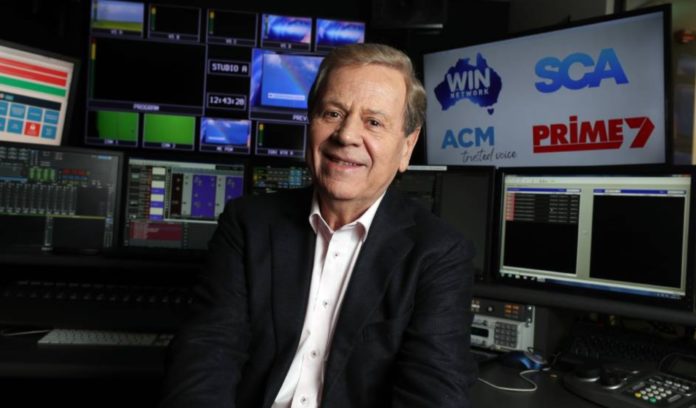Regional Australia’s local TV newsrooms, newspapers and radio shows are closing at alarming rates.
Without urgent regulatory reform by the federal government, regional communities will lose access to fact-checked, balanced and independent local news reporting.
For seven years, the regional media industry has lobbied the federal government for urgent reforms to enable them to compete on a commensurate basis with Google, Facebook and the metropolitan networks – all of whom now stream into regional areas via the NBN and at the expense of your local media.
Presented by Ray Martin, ‘The Local Angle’ looks at the important work of local TV, radio and newspapers in regional Australia.
It reveals how they go beyond reporting the local news to also provide free advertising and marketing support for vital medical services, charities and amateur sporting organisations across Australia.
Discussing the program, Ray Martin said:
“This is a program about the increasing loss of community voices in regional Australia, which has left many regional towns and cities without a local TV news service, breakfast radio program or a newspaper. Without local media to represent them, they will never be heard in Canberra or Macquarie St or Spring St.”
Martin adds that newspapers and local TV newsrooms are slowly fading and switching off across the country.
“We must save these trusted local media voices that connect communities and inform them of local events and issues. If we fail, our communities, our society and our democracy, will be the poorer for it.”
For more information go to the SAVE OUR VOICES website www.saveourvoices.com.au and sign the www.change.org/saveourvoices petition.


These remarks are not intended to be a thesis on the Broadcast Services Act (Cth) (‘BSA’).
On regional radio, according to the Broadcast Services Act (Cth), sections 43B and 43C (ss43C(1) and (8)), the regional radio station must broadcast local content between 0600 and 1800. source https://www.legislation.gov.au/Details/C2020C00364. The definition of regional radio is defined by what is a metropolitan station. Section 61C defines a metropolitan station as one that has General Post Office in the licence area. So if a licence area (market) does not have a GPO, then the radio station is a regional station.
The irony is that a metropolitan station can be networked 24 hours a day from another region. For example, until recently, 4BC was mostly networked from 2GB.
Similarly in regional TV has local content requirements under the ‘BSA’. Section 43AA requires regional tv broadcasters who distribute their programs via satellite (s38C) to broadcast local news. Division 5D of the Broadcast Services Act (Cth) mandates local content requirements for each each state is divided into broad regions according to the nature of type of method of broadcasting, s61CU (definitions), s61CW for aggregated regional broadcasters, s61CX for non-aggregated regional broadcasters, s61CYA for WA commercial broadcasters.
As I said at the start of the remarks, this is not a thesis on the ‘BSA’.
Generally, depending on the size of the licence area (market), consolidation and closure of local news rooms, the broadcaster may still be compliant with the local content requirements under the law, especially if the license area covers many regional areas. Practically, where there were many newsrooms within the licence area, having only one newsroom broadcasting to the licence area is still compliant with the law.
Similarly, over 200 regional newspapers have been subject to consolidation, offering online-only services or closure.
Sources:
https://www.abc.net.au/news/2020-06-18/regional-newspaper-cuts-leave-locals-fearing-loss-of-community/12359058
https://www.afr.com/companies/media-and-marketing/regional-newspapers-needed-tough-love-news-corp-s-thomson-20200617-p553cg.
Other regional newspapers have started by ex-employees of the closed publication, https://www.abc.net.au/news/2020-07-28/regional-newspapers-queensland-replace-new-corp-editions/12494426 or supported by the community, https://www.adnews.com.au/news/advertising-can-still-support-community-newspapers-just-not-for-big-business .
Then we must not underestimate community radio. Good community radio stations require their on air presenters to sound professional and some radio stations may provide a training ground for future media journalists, for example 2SER-fm.
If community radio and newer regional newspapers satisfy the regional audiences, then it is a sign that these entities are providing what the audience and readers want that are not fulfilled by the regional broadcaster and .
Furthermore more studies are needed on the economics of regional radio and television over time. Issues to raise include why regional radio stations which were once totally local now depend on external sources of programming from 1800 to 0600 and why supplementary licences to the regional broadcaster, usually an FM licence broadcast music exclusively from the capital cities.
Similarly, what are the economics underlying what was once many newsrooms in a particular regional area to consolidating the number of newsrooms to one newsroom in a particular licence area? Is it due to the advertisers choosing other media for more effective returns for the advertising dollar?
If the advertisers are utilising other media to advertise, is that due to the choices of preferred media by the listener, viewer or reader in that regional area?
Remember, today with satellite distribution and internet distribution of program content, the viewer has a plethora of choices compared to the 1991 aggregation of television networks in regional areas.
Since the aggregation of tv networks in the early 1990s, the regional viewer has more choices than the single regional station that sourced its program content from the capital city networks. DVB (digital TV) has increased the choices with multi-channelling. If the viewer is not happy with the reality-TV fare, there are even more choices with online services such as Netflix, Stan, AppleTV, Amazon. There’s also DVD and Blu-ray offerings. Let’s not forget our ABC and SBS.
What is the price for many choices? Revenues for commercial tv broadcasters have fallen despite the pandemic. Lower revenues to the commercial result in fewer services and that includes the more localised regional tv news services which has been taken for granted.
Consequently, the decision by the broadcaster’s management to reduce the number of newsrooms for a particular broadcast licence area while still complying with the regional TV news requirements under the BSA is the price to pay.
Are regional viewers prepared to reduce consumption of other media in order to support regional tv broadcasters? You cannot take for granted that comprehensive news services will always be there despite your choices to view many other media. Follow the advertising dollar.
Thank you,
Anthony of exciting Belfield